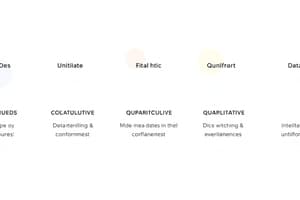Podcast
Questions and Answers
Which sampling method ensures every entity in the experimental unit has an equal chance of being selected?
Which sampling method ensures every entity in the experimental unit has an equal chance of being selected?
- Systematic random sampling
- Simple random sampling (correct)
- Cluster sampling
- Stratified random sampling
What is the main characteristic of stratified random sampling?
What is the main characteristic of stratified random sampling?
- It randomly selects entities based on local variability.
- It selects every nth entity from a continuous list.
- It involves dividing the population into clusters before selecting samples.
- It divides the experimental unit into distinct subunits before sampling. (correct)
Which sampling method is most appropriate when the entire population is homogeneous?
Which sampling method is most appropriate when the entire population is homogeneous?
- Stratified random sampling
- Cluster sampling
- Systematic sampling without strata (correct)
- Stratified systematic sampling
What is a primary reason for using systematic stratified sampling over simple random sampling?
What is a primary reason for using systematic stratified sampling over simple random sampling?
What defines cluster sampling?
What defines cluster sampling?
What type of data is specifically collected from the source for a particular purpose?
What type of data is specifically collected from the source for a particular purpose?
Which statement accurately describes raw data?
Which statement accurately describes raw data?
What is a key requirement for the measuring instrument used in data collection?
What is a key requirement for the measuring instrument used in data collection?
Why is random sampling important in research?
Why is random sampling important in research?
Which of the following describes secondary data?
Which of the following describes secondary data?
Flashcards are hidden until you start studying
Study Notes
Data Collection Overview
- Data, derived from the Latin word ‘dare’ meaning "to give", refers to pieces of information.
- It encompasses both qualitative and quantitative variables and can include numbers, words, images, and colors.
- Data can be categorized as raw or processed; raw data is unaltered original measurements, while processed data has been transformed for analysis.
Types of Data
- Primary data is collected directly from sources for a specific purpose, often as raw data by the researcher.
- Secondary data is reused from previous studies and collected for different purposes, providing contextual information that may differ from the original intent.
Importance of Measurement
- Validity and reliability of measuring instruments are crucial in data collection.
- Measurements should be rechecked to avoid errors that could skew results and conclusions.
- Research often infers population characteristics from samples, necessitating the use of random sampling methods.
Sampling Techniques
- Sampling involves selecting groups from which data will be collected to test hypotheses about population characteristics.
Common Sampling Methods
- Simple Random Sampling: Random selection of entities using devices like random number tables, allowing equal probability for all entities.
- Stratified Random Sampling: The population is divided into distinct subunits or strata, and samples are randomly chosen from each stratum to minimize local variability.
- Systematic Random Sampling: Involves division of the population based on a calculated interval (nth) thereby systematically selecting samples.
- Cluster Sampling: Population is divided into clusters (e.g., districts or schools) and entire clusters are randomly chosen for sampling.
- Stratified Systematic Sampling: Combines stratified and systematic sampling, used when certain sub-populations can be isolated, helping maintain representative sampling.
Advantages of Systematic Stratified Sampling
- Reduces the cost per observation in the survey.
- Provides more accurate estimates when dealing with heterogeneous populations.
Studying That Suits You
Use AI to generate personalized quizzes and flashcards to suit your learning preferences.




